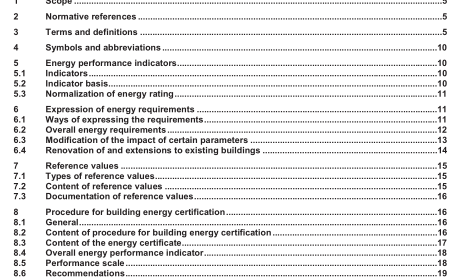EN 15217:2007 – Energy performance of buildings – Methods for expressing energy performance and for energy certification of buildings

1 Scope
This European Standard specifies:
a) overall indicators to express the energy performance of whole buildings, including heating, ventilation, air conditioning, domestic hot water and lighting systems. This includes different possible indicators;
b) ways to express energy requirements for the design of new buildings or renovation of existing buildings;
c) procedures to define reference values;
d) ways to design a procedure for building energy certification.
The standard can be applied to a group of buildings, if they are on the same lot, if they are serviced by the same technical building systems and if no more than one of them has a conditioned area of more than 1 000 m 2 .
This European Standard provides different options at different levels. When this European Standard is used to set up national or regional methods for expressing energy performance and/or for energy certification of buildings, the choices between the options is not made by the individual user, but by authorized national or regional bodies.
2 Normative references
The following referenced documents are indispensable for the application of this document. For dated references, only the edition cited applies. For undated references, the latest edition of the referenced document (including any amendments) applies.
EN ISO 7345:1995, Thermal insulation — Physical quantities and definitions (ISO 7345:1987)
prEN 15603 1) , Energy performance of buildings — Overall energy use and definition of energy ratings
3 Terms and definitions
For the purposes of this document, terms and definitions given in prEN 15603 and in EN ISO 7345:1995 and the following apply.
3.1
energy certification
procedures enabling to produce an energy certificate
3.2
energy certificate
document recognised by a member state or a legal person designated by it, which includes the energy performance of a building
NOTE The meaning of the terms “certificate” and “certification” in this European Standard differ from that in EN ISO/IEC 17000.
3.3
energy class
easy to understand metric (e.g. A to G) for indicating the energy performance of a building
3.4
reference value
standard legal or calculated value against which an energy indicator is compared
3.5
energy performance requirement
minimum level of energy performance that is to be achieved to obtain a right or an advantage: e.g. right to build, lower interest rate, quality label
3.6
calculated energy rating
energy rating based on calculations of the weighted net delivered energy used annually by a building for heating, cooling, ventilation, domestic hot water and lighting
NOTE National bodies can decide whether other energy uses resulting from occupants’ activities such as cooking,production, laundering, computer equipment etc. are included or not. If included, standard input data needs to be provided for the various types of building and uses. Lighting is always included except (by decision of national bodies) for residential buildings.
3.7
standard energy rating
calculated energy rating using actual data for a building and a standard use data set
NOTE 1 The thermal envelope area represents the intrinsic annual energy use of a building under standardised conditions. This is particularly relevant to certification of standard energy performance.
NOTE 2 It can also be termed “asset energy rating”.
EN 15217:2007 – Energy performance of buildings – Methods for expressing energy performance and for energy certification of buildings